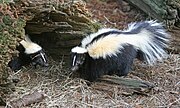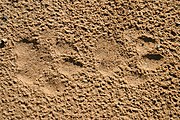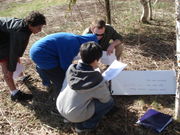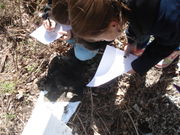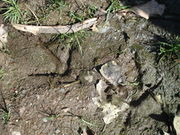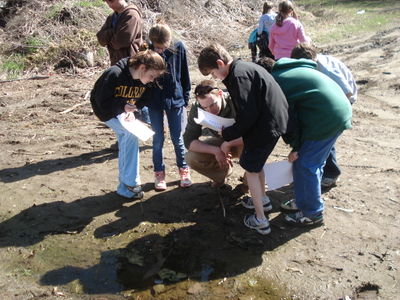Mystery tracks
Biology in Middle Schools home | |Elementary School sister project
Biology In Middle Schools is a Saint Michael's College student project. Link under 'toolbox' for a printer-friendly version. Click on handouts to print full resolution versions. Please see Wikieducator's disclaimer, our safety statement, and the Creative Commons licensing in English and in legalese.
Primary biological content area covered
This activity will expose students to the natural fauna of Colchester Vermont through the experiential exploration and identification of small mammal tracks.
Materials
- Footprint Trays
- Bait (Single-serving Peanut Butter)
- Animal Track Guide (provided as a handout)
- Mystery Tracks Worksheet (provided as a handout)
- Ruler
Handouts
Each student will be given an Animal Tracks Pocket Guide courtesy of Vermont Fish and Wildlife Department. The will also be given a list of questions to answer about the track they have selected to match the track on their index card, these questions are meant to help explain their choice.
Description of activity
Guided identification of small mammal tracks in Colchester, VT.
The Footprint Trays
(see Figure 4.)
- Trays do not capture or harm any animals
- Upon entering tray animal crosses an aluminum sheet covered in soot
- The middle section of the tray is covered in contact paper sticky side up
- Soot tracks are left on the contact paper
- Animal collects peanut butter and leaves
- Return later and remove contact paper to identify tracks
Location
Near the Saint Michael's College compost pile. Located:(44°29’N, 73°09’W)
Lesson plan
Logistics
Greet the students and parents and introduce ourselves. Educator(s) will begin by explaining some of the basics of animal track identification. After students will be divided into groups, and will be given an Animal Tracks Pocket Guide and a handout to complete. Each group will locate footprint trays and identify the tracks they find using using their Pocket Guide handout and record using their Mystery Tracks Worksheet what animals are represented (see Handouts section). Students can work in pairs or individually to identify tracks. After identifying one track a student may move on to another or assist a peer in identification. After each group of students has completed identification the entire group will reconvene at a central location to discuss each groups findings. Each group will have to explain using the information from their Mystery Tracks Worksheet why they believe that they have discovered evidence of the animal they identified.
Animal Track Identification
It is most likely that we will see tracks from small mammals from the Rodent Family as well as Rabbits and Hares, however, comparing them to the tracks of other animals gives a good sense of the variety of tracks that animals can make.
General Track Shapes
Rodent Family
- General Cross Pattern
- 4 toes on front feet
- 5 toes on rear feet
- claws
- Gallopers from this family include: Squirrels (see Figure 2. ), Mice, Rats, Chipmunks, and Ground Hog
- Pacers from this group include: Porcupine, Muskrat, and Beaver
Rabbits and Hares
- General shape of front feet is circular and rear footprint may include the elbow and appear more elongated
- 4 toes on front feet
- 4 toes on rear feet
- Rear feet of the rabbit are double the size of the front feet while the rear feet of the hare tend to be 4-5 times larger than their front feet
- Rabbits and hares tend to be gallopers
Cat Family
- General shape is round
- 4 toes on front feet
- 4 toes on rear feet
- claws will rarely show
- Front feet tend to be slightly larger than the rear
- Tend to be Diagonal Walkers
- This group includes: Cat, Mountain Lion, Bobcat (larger inner toes and cleft in heel pad) and Lynx (larger outer toes see Figure 3.)
Dog Family
- General shape is Oval
- 4 toes on front feet
- 4 toes on rear feet
- Claws
- Front feet are slightly larger than the rear feet
- Generally Diagonal Walkers
- This group includes: Dog (larger inner toes) , Fox, Wolf, and Coyote (larger outer toes)
Weasel Family
- Generally box shaped or rectangular
- 5 toes on front feet
- 5 toes on rear feet
- Have claws
- Generally bounders
- This group includes: Weasels, Mink, Otter, and Badgers
Deer Family
- General shape of an upside-down heart
- 2 toes on front feet
- 2 toes on rear feet
- Front feet are slightly larger than rear feet
- Members of this family tend to be Diagonal Walkers
Others
- General shape is human-like
- 5 toes on front feet
- 5 toes on rear feet
- Claws
- Members of this group tend to be Pacers
- This group includes: Raccoon (see Figure 1.), Opposum, Bear and Skunk
Additional Info
Movement Patterns
- Diagonal Walkers- move both right and left sides of the body at the same time.
- Bound Walkers- the front feet move together and the back feet move together to land just behind the front feet.
- Gallop Walkers- the front feet move together and the back feet move together to land just in front of the front feet.
- Pacers- move the left side and the right side alternately
Animal Track Identification information courtesy of the USSARTF.org, Document created by Rick Curtis
Potential pitfalls
This lesson plan is based on capturing evidence of animal species in the area in the form of animal tracks. It relies on the bait in conjunction with footprint trays to attract the animals and provide evidence of their presence, therefore there is always the possibility that no tracks will be left in the footprint trays either due to avoidance by the animals or weather conditions. This activity is also somewhat dependent on a diversity of animal tracks which should be ensured by using two different types of bait (Single-serving Peanut butter and Chicken).
Math connections
Use of rulers in measurement is an important skill that will be addressed in this lesson. Measurement of the tracks will aid students in determining the identity of the track.
Literature connections
Possible Follow up reading material:
Wild Tacks!: a guide to nature's footprints by Jim Arnosky
The Woods Sientist by Stephen R. Swinburne
Complete Tracker: tracks,signs, and habits of North American wildlife by Len McDougall
All available at the SMC Durick Library!
Connections to educational standards
| DOK & NECAP Release Item Codes |
GE Statement with Ceiling DOK | Science Concepts | Examples/ Practice Items |
| Enduring Knowledge: Energy enters an ecosystem in the form of sunlight and flows through the system to each cell. Matter interacts, changes and recycles in an ecosystem. Populations of organisms survive by maintaining interdependent relationships with one another and by utilizing biotic and abiotic resources from the environment. | |||
| DOK 3 LS1(5-8) INQ + SAE-1 LS2(5-8) INQ + SAE -5 LS2(5-8) SAE -6 LS2(5-8) SAE -7 |
S5-6:36 (DOK 3) Students demonstrate their understanding of Equilibrium in an Ecosystem by… · Experimenting with a closed system and drawing conclusions about how an environmental change affects the system (e.g., bottle biology). |
Science Concept: a. The number of organisms an ecosystem can support depends on the kinds of organisms present and the availability of biotic and abiotic resources (i.e., quantity of light and water, range of temperatures, and soil composition). |
|
This lesson plan is a way of gaining insight into a local ecosystem. This ecosystem is influenced by a number of factors including the Saint Michael's College Compost Pile as well as the near-by Winooski River. Based on this information as well as the animal tracks that are found during the activity the students will gain an understanding of the types of species that can be supported by an area with these resources.
Next steps
What do the foot prints found tell us about the fauna of Chittenden county?
What are the impacts of Humans on these animals?
Potential follow up lesson: creating cast and molds of animal footprints
Reflections
Overall, the activity went very well. The kids seemed excited to look at and figure out what kind of animals had visited the footprint trays (see Figure 5.). They were less interested in what the animal tracks might tell us about the environment that they live in, or why we might have seen some animals in the fields and not near the compost or vice versa. Fortunately we were able to get a variety of footprints for the kids to look at and even found some surprise footprints near the compost area where we set some of our traps. These included what might have been a wild turkey (see Figure 6.) and a coyote (see Figure 7.). The students seem to like this aspect the best, it prompted them to share their own experiences with finding evidence of animals in their backyards or neighborhoods. Unfortunately finding footprints outside of the trays that we set up is not always guaranteed, but is a wonderful surprise because it allowed us to look at prints that we could not have gotten due to the constraints of the footprint trays and bait used. If footprints were found by the compost area consistently we might be able to alter the activity to include footprint casting in addition to the identification using the guide. It seems that interest in the footprints of animals from the kids was much higher when the tracks were found in the area's natural substrate. For the short amount of time that we had the worksheet was not a top priority to the students, they were much more interested in the hands on part of the activity. Thankfully the worksheet was mainly a guide to identifying the track in the event that one of us was not able to help guide them through. The size of the groups allowed us (3 people to 7-8 students) to work with them in identifying. Also, we had hoped to discuss what the animal tracks we found my tell us about their habits or the environment that we lived in. Time constraints did not allow us to go into much detail but we were able to discuss our findings as a group and question students on an individual basis about the relevance of the tracks that were found. This activity worked well but perhaps could have used more hands-on activities like looking for the tracks or even if we had been able to have them put out the footprint trays in different areas and come back to find them, this would not have worked in our time frame though. The only addition I see as being feasible is making footprint molds in addition to identifying the tracks. As is, the activity still provided some very interesting tracks from a variety of different animals including skunk and fox and I believe that both students and educators had a fun and enriching experience!
Citations and links
Vermont Educational Standards, grade 5-6, Life Sciences
Vermont Fish and Wildlife Department, Fact sheet
Animal Tracking: Curtis, Rick. "Animal Tracking." United States Search and Rescue Task Force. USSART, n.d. Web. 2 Apr 2010. http://www.ussartf.org/animal_tracking.htm.
While brand new ideas are very valuable and most welcome here, tried and trusted ideas of others will probably make up the bulk of the material on this site. It is important to respect the copyrights of others, and also to acknowledge their ideas. A full citation to published materials is essential and also useful. If there are online materials that would be useful to supplement your program, link to them from here.
| Work in progress, expect frequent changes. Help and feedback is welcome. See discussion page. |

